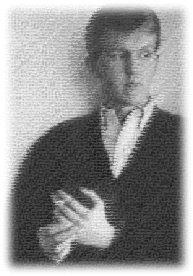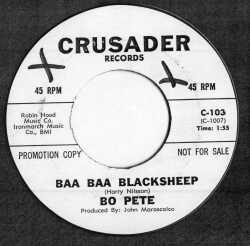![]()
 Early
Singles and Demos
Early
Singles and Demos
![]()
From the time Harry recorded the songs for Scott Turner in 1962 to the release of his first album ‘Spotlight on Nilsson’ in 1966 he continued to work a dual life as the bank’s computer wiz and part time musician. Several times he took a few tentative steps towards stardom, only to be thwarted by reluctant A&R men, lack of promotion and a general apathy towards new American artists in the wake of The Beatles ‘and all things British’ domination in the early sixties.
By the time he and Turner went their separate ways Harry had met many of his writing partner’s friends and associates who were almost universally impressed by the youngster’s songwriting talent and unique voice. John Marasalco himself lent Nilsson the $300 he needed to make his first record. Dragging a group of female backing singers literally soaking wet off the street and into the studio they recorded a poppy version of the nursery rhyme ‘Baa, Baa Black Sheep’, released on the Crusader Label under the name of Bo Pete in February 1964. The single’s b-side ‘Do You Wanna Have Some Fun?’ pointed towards better things…
1964 - Stand Up and Holler (Nilsson/Marasalco) - FotoFi
Two years after Harry recorded the session with Scott Turner the pair, who wrote several songs together, had drifted apart but Harry continued to see what benefit he could gain by associating with contacts he had met through Turner. One such contact was John Marasalco, of course. In fact, it was Marasalco who put up the $300 needed for Harry to record this song, which was released as a single on the Foto-Fi label, under the assumed name of Foto-Fi (or sometimes, you may read, 'The FotoFi Four'). The song is a homage to the arrival of The Beatles in America. (One is married but three are single, sings Harry in obvious reference to the fact John's marriage to Cynthia was 'hushed up') The B-side was the same as the A-side, re-edited to go along with film footage of the Fab 4 arriving in the USA, complete with overdubbed screaming.
 1964 -
Baa Baa Black Sheep (parts I and II) - Bo Pete
1964 -
Baa Baa Black Sheep (parts I and II) - Bo Pete
Bo Pete was, according to Harry, someone else entirely - as Harry said in 1982, "We did some demos in a studio with a guy named Bo Pete," but it was under this name that the single was released and the similarity of the name to Bo Peep makes this connection tenuous to say the least. However, the nursery rhyme IS the single. The girl backing singers were picked off the street (they claimed to call themselves The Beach Girls). Released on the Crusader label in February 1964.
1964 - Do You Wanna Have Some Fun (Nilsson/Marasalco)/Groovy Little Suzie (Nilsson) - Bo Pete
The second release from Bo Pete featured another collaboration with John Marasalco. Marasalco even persuaded Little Richard to record Groove Little Suzie, which Nilsson admitted he had based on 'Good Golly, Miss Molly', although on that version it is credited solely to Marasalco. Released on the Try label at least the songs here were more like what we would later come to expect of Harry Nilsson. The B-side prompted the comment from Little Richard "My, you do sing good for a white boy---I hope you don't mind my sayin' white"
1964 - Wig Job (Lee)/Donna, I Understand (Nilsson) - Johnny Niles
Single released on the Mercury label. This is the single that enabled Harry's career to finally start moving. The A-side is a bland, silly affair by Buddy Lee. Curtis Armstrong once described it as "execrable" - a fair critique. The B-side, however, written about a girl who worked in the bank with Harry, drew the attention of executives. While not a 'classic' it is a big improvement on what had preceded it and Harry is at least able to showcase his amazing vocal range and breath control. When the label heard the single they rated the B-side far higher than the A-side and some time later Nilsson was given the chance to showcase his talents on the ‘Spotlight’ album, backed by the New Salvation Singers - finally as Harry Nilsson!
1965 - Wig Job (Lee)/Donna, I Understand (Nilsson)
Sometime in 1965 this single re-emerged on the Spindle Top label...but not, strictly, as a re-release. These were two entirely new versions of the songs. Both the arrangements and vocals were new, the story behind why is unclear. Certainly Harry was both a perfectionist and a revisionist (note Aerial Pandemonium Ballet's re-hashed versions) and this may be another, early example of this trait. Re the new arrangements, I find the schmatlzty saxophone on this 'Donna' go some way towards spoiling a nice enough song...the awful female backing vocals certainly finish the job!!!